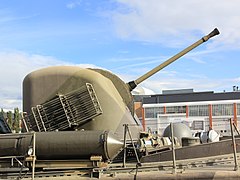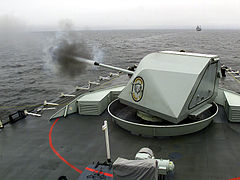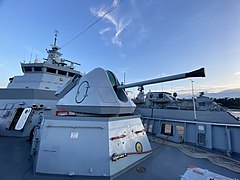| Bofors 57 mm Naval Automatic Gun L/70 | |
|---|---|
 A Mk 110 57 mm gun on the littoral combat ship USS Freedom | |
| Type | Naval artillery |
| Place of origin | Sweden |
| Service history | |
| In service | 1971–present |
| Used by | See users |
| Production history | |
| Designer | Bofors Defence |
| Designed |
|
| Manufacturer |
|
| Produced |
|
| Variants | See variants |
| Specifications | |
| Mass | Mark 3: 14,000 kg (31,000 lb) (weight including 1,000 rounds onboard, each weighing 6.5 kg (14 lb) per complete round) |
| Barrel length |
|
| Shell | 57 × 438 mm R (m/70) 6.1 kg (13 lb) complete round 2.4 kg (5.3 lb) pre-fragmented shell |
| Caliber | 57 mm/70 caliber |
| Barrels | Single barrel (progressive RH parabolic twist, 24 grooves) |
| Action | Electronic firing |
| Elevation |
|
| Traverse | Full 360°:
|
| Rate of fire |
|
| Muzzle velocity | 1,035 m/s (3,400 ft/s) (HE round) |
| Effective firing range | 8,500 m (9,300 yd) (HE round) |
| Maximum firing range | 17,000 m (19,000 yd) (HE round at 45°) |
| Feed system | Magazine:
|
| Sights | Gyro-stabilized in local control. |
The Bofors 57 mm Naval Automatic Gun L/70 (Swedish: 57 mm sjöautomatkanon L/70 (57 mm SAK 70)),[1][2] among other names, is a series of dual-purpose naval guns designed and produced by the Swedish arms manufacturer AB Bofors (since March 2005 part of BAE Systems AB), designed in the late 1960s as a replacement design for the twin barreled Bofors 57 mm Naval Automatic Gun L/60. The gun is remotely controlled by a fire-control computer but can as a redundancy measure also be operated manually by crew using instrument panels either on or in direct contact with the gun.[3]
The gun has been upgraded and improved several times:
- Mk1 – The baseline Mark 1 variant began production in 1970 and was initially used to equip smaller coastal patrol craft and fast attack craft.
- Mk2 – The improved Mark 2 variant came in 1981 and drastically lowered the weight as well as introduced new servo stabilizers.
- Mk3 – The improved Mark 3 variant came in 1995 and primarily features the ability to use programmable ammunition.[3]
While the 57 mm cannon may not seem as powerful as larger naval guns, such as the OTO Melara 76 mm, some of its performances are comparable; given its rate of fire and amount of explosive per shell, the Bofors gun actually achieves a higher amount of "explosive fired per second" than the 76 mm.[4]
Although the Swedish Navy has been the primary user of the gun, it has been exported widely by Bofors Defence for use by the navies of Brunei, Canada, Croatia, Finland, Indonesia, Ireland, Malaysia, Mexico, Montenegro, Singapore, Thailand, and the United States.
Names[edit]
The gun is formally known under a variety of names around the globe. Internally at Bofors (now BAE Systems AB) it usually goes under names incorporating the Bofors term 'SAK', an acronym for 'SjöAutomatKanon', meaning "Sea Automatic Cannon" (literal) or "Naval Automatic Gun" (formal).[1][2] Some examples being: 57 mm SAK 70[1] (57 mm sjöautomatkanon L/70) and SAK 57 Mk1, SAK 57 Mk2, SAK 57 Mk3, etc.[2] Not to be confused with the Bofors 57 mm Naval Automatic Gun L/60 which has gone under similar names like 57 mm SAK 60 (57 mm sjöautomatkanon L/60).[1] BAE Systems has also stated on their website that the current generation of the weapon, the mark 3, is simply known as the 57Mk3 internally as of 2011.[5]
Design and development[edit]
The Bofors 40 mm L/60 anti air gun (1.6 inch) was one of the most popular naval anti-aircraft guns during World War II, used long after the war in a variety of roles. However, as jet aircraft became more prevalent in the post-war era, it was clear the gun did not have the rate of fire needed to effectively deal with these threats. Flying at speeds close to 1,000 kilometres per hour (620 mph), a jet aircraft flew through the effective range of the Bofors 40 mm gun in too short a time for the gun to fire enough rounds to ensure a hit.
Bofors' engineers considered two solutions to the problem. One was to greatly increase the firing speed of the 40 while also incorporating any minor changes that would improve its range. This produced the 40 mm L/70, which remains popular to this day. The other was to design a larger weapon with much greater effective range and a larger explosive load that offset a lower firing rate. This eventually resulted in the single-barreled Bofors 57 mm Automatic A.A. Gun L/60 and twin-barreled Bofors 57 mm Naval Automatic Gun L/60 in 1950.[1] The 57 mm L/60 systems were however far from ideal; they had a low rate of fire and were very big and heavy, especially the twin-barrel system. Due to the ever-improving performance of jet aircraft, a new and improved base design was needed by the late 1960s. The focus of the new design was to increase velocity, range and firing rate. This design became the 57 mm Naval Automatic Gun L/70.
Mark 1[edit]
The baseline version of the new gun, later known as the Mark 1, used a cartridge with the same case-length as the cartridge on the 57 mm Naval Automatic Gun L/60 (57 mm x 438 mm) but with a new shape and propellant, giving it an increased velocity of 1,025 m/s (3,360 ft/s), compared to 890 m/s (2,900 ft/s) on the L/60 cartridge.[6][1] Fire rate was also higher on the L/70 design: 200 rounds per minute, compared to 130 rounds per minute per barrel on the 57 mm L/60-design.[1] The Mark 1 gun mount featured a 40-round magazine and a further 128 rounds were stowed inside the Mark 1 turret.[3] Aiming operation was performed by a new electro-hydraulic system for rapid training and elevation.
-
Bofors 57/70 Mark 1 firing from a Swedish Norrköping-class missile boat.
-
Bofors 57/70 Mark 1 on a Swedish Norrköping-class missile boat.
-
Bofors 57/70 Mark 1 on a Swedish Norrköping-class missile boat.
-
Bofors 57/70 Mark 1 on a Swedish Norrköping-class missile boat.
The 57 mm L/70 Mark 1 was introduced into the Swedish Navy in 1971 as the 57 mm automatpjäs 7101 (57 mm apj 7101) on the Norrköping-class fast attack craft, also known as the Spica-II-class (not to be confused with the Spica-class torpedo boat (Spica-I)).[1] It featured two ammunition hoists. A second variant designated 57 mm apj 7102 was introduced in 1972 on the patrol boat HSwMS Jägaren. It was similar to the 7101 but featured only a single ammunition hoist.[1] Besides Sweden, the Mark 1 also saw adoption with Finland, Malaysia, Norway, Indonesia, Singapore and (the former) Yugoslavia.
Mark 2[edit]
The Mark 2 was an improved variant of the gun designed in 1981. It featured a slightly higher rate of fire of 220 rounds per minute, had a lighter weight, and utilized a new servo drive/servomechanism system which compensates for barrel oscillations during firing, increasing the hit probability.[1] According to Bofors, the new servo system allowed the Mark 2 to be both accurate and agile enough for use against sea skimming anti-ship missiles and that it could put more explosives into a surface target within a thirty-second window than any naval gun with a calibre smaller than 100 mm (3.9 in).[3] The Mark 2 gun is fitted with a 40-round ready-use gun-magazine with four vertical 10-round compartments. There are also cassettes inside the mounting for 80 more ready to use rounds (120 rounds total in the mounting). Ammunition is hoisted manually into the mounting using two manual-hoists which feeds from the ammunition-room below the mounting.[1] Bofors claims that with 120 ready rounds the system can sufficiently engage 1 to 2 surface targets and 4 sea skimming missiles.[1]
To remove weight from the design, the Mark 2 variant omitted the water-cooling used on the Mark 1. This meant a lighter barrel and gun mount. According to Bofors, water-cooling was not needed for the modern missions the Mark 2 was used for. Bofors even recommended that water-cooling be removed from older mountings.[1] The Mark 2 gun barrel was also forged from monobloc steel to help with heat-wear from the lack of water-cooling.[3] The Mark 2 mounting originally also had room for a gun operator, however, the compartment was too narrow for practicality and the wind-shield proved to be a source for radar-reflections, and was quickly replaced by a TV-camera.[1]
-
Bofors 57/70 Mark 2 firing from a Canadian Halifax-class frigate.
-
Bofors 57/70 Mark 2 on the Malaysian frigate Jebat.
-
Bofors 57/70 Mark 2 on the Malaysian frigate Jebat.
-
Bofors 57/70 Mark 2 on the Malaysian frigate Jebat.
-
Bofors 57/70 Mark 2 on the Malaysian frigate Lekiu.
The 57 mm L/70 Mark 2 was introduced into the Swedish Navy in 1985 as the 57 mm automatpjäs 7103 (57 mm apj 7103) on the Stockholm-class corvette—HSwMS Stockholm (sister ship HSwMS Malmö was built in 1984 but armed with the older Mk1, subsequently retrofitted with the Mk2 in 2009). An improved version designated 57 mm automatpjäs 7103B (57 mm apj 7103B) was introduced in 1990 on the Göteborg-class corvette.[1] Beyond Sweden the Mark 2 also saw adoption by Canada and four other navies.[1] Bofors has manufactured a total of about 25 Bofors 57 mm L/70 Mark 2 guns.[3]
Mark 3[edit]
The latest development of the gun is the Mark 3, designed in 1995 for use on the then planned Visby-class corvette. The Mark 3 system has kept the same rate of fire and ammunition capacity as the previous Mark 2 system but has added many features to make it a modern system. Some of the primary changes includes: the ability to use Bofors 3P all-target programmable ammunition, the addition of a small muzzle velocity radar housed in a radome externally above the gun barrel for measuring the muzzle velocity of the departing projectiles for fire-control purposes, usually but not necessarily with the new Bofors 57 mm 3P ammunition, the ability to instantly change ammunition types by the use of a dual-feed system, another 1,000 rounds stowed in the standby rack beneath deck, as well as an improved fire control system. The Mark 3 system can also be operated/fired manually without the FC system using a joystick and video camera (mounted on the gun). The camera is fitted as standard.[1]
For the Visby-class corvette Bofors also developed a new optional low radar profile (also known as low radar cross-section, or RCS) stealth mounting (also known as a cupola), which allows the gun to be hidden from radar and plain sight when not in use.[3] The stealth mount/cupola is made of carbon-fibre-reinforced polymer and has a very distinctive angular, low signature.[1]
-
Bofors 57/70 Mark 3 (Mk 110) with standard mount firing from an American Freedom-class littoral combat ship.
-
Bofors 57/70 Mark 3 with standard mount on Finnish missile boat Hamina-class missile boat.
-
Bofors 57/70 Mark 3 with stealth mount in "transport mode" aboard a Visby-class corvette.
-
Bofors 57/70 Mark 3 with stealth mount in "fire mode" aboard a Visby-class corvette.
The Bofors 57 mm SAK L/70 Mk3 was introduced into service with the Visby-class corvette—fitted on HSwMS Visby in the year 2000. It has since also been adopted by a variety of nations, such as Finland and the United States. In American service, the United States Navy has designated the Mark 3 as the Mark 110 Mod 0 57mm gun. According to a BAE Systems press release dated 1 August 2005, the Mark 110 would be manufactured at the BAE Systems facility in Louisville, Kentucky.[3] BAE Systems has been awarded a contract by General Dynamics to provide two additional Mk110 Naval Gun Systems for the Independence variant of the US Navy's (USN's) Littoral Combat Ship (LCS).[7]
Ammunition[edit]
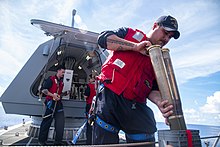
Ammunition for the Bofors 57 mm gun is produced by BAE Systems, Sako Limited in Finland, SME Ordnance in Malaysia and Nammo in Norway.[3]
In 2006, BAE Systems AB began to offer the Bofors 57 mm 3P all-target programmable ammunition, this allows three proximity fuzing modes as well as settings for time, impact, and armor-piercing functions. This increases the flexibility and effectiveness of the gun system, which has further reduced the reaction time of the gun and it is possible to choose ammunition mode at the moment of firing, giving it the ability to switch rapidly between surface targets, air targets, and ground targets.[8]
In April 2015, BAE Systems unveiled a new round for the Mk 110 in the design stage called the Mk 295 Mod 1 Ordnance for Rapid Kill of Attack Craft (ORKA), made to achieve one shot kills of surface and air threats. Answering a U.S. Navy requirement for increasing the accuracy and efficiency of naval rounds, the ORKA leverages technology BAE Systems developed for larger 127 mm and 155 mm guided rounds, using a 4-canard actuation systems to guide the round. It is fitted with a multi-mode imaging semi-active seeker that can be guided through laser designation or autonomous targeting by downloading image of the target prior to firing; ORKA retains the 3P multiple fuzing modes.[9]
In December 2015, the U.S. Navy revealed they were working on developing a guided 57 mm round for its Mk 110 guns on the Littoral Combat Ship and other Navy and Coast Guard ships.[10] Northrop Grumman was awarded a contract to develop a self-guided 57 mm shell for the Mk 110 in October 2023.[11][12]
On 22 August 2017 L3 Mustang Technology (part of L3Harris Technologies) announced the completion of the Critical Design Review (CDR) phase for the U.S. Navy's MK 332 Mod 0 High-Explosive, 4-Bolt Guided (HE-4G) projectile. The round was developed from the Advanced Low Cost Munitions Ordnance program. It is intended for use on the LCS and the new fast Frigate, and the US Coast Guard's Legend and Heritage class cutters.[13]
Variants[edit]
- Bofors 57 mm SAK L/70 Mk1
- Baseline version from 1970. 200 rounds per minute rate of fire, water-cooled.
- Bofors 57 mm SAK L/70 Mk2
- Improved version from 1981. 220 rounds per minute rate of fire, lighter weight, new servo system, no water-cooling.
- 57 mm automatpjäs 7103 (57 mm apj 7103) – Swedish navy version for the Stockholm-class corvette.[1]
- 57 mm automatpjäs 7103B (57 mm apj 7103B) – Swedish navy improved version for the Göteborg-class corvette.[1]
- 57 mm allmålskanon Mk2 – Post 2001[14] designation for the 57 mm apj 7103A and 7103B.[15]
- Bofors 57 mm SAK L/70 Mk3
- Improved version from 1996 based on the Mk2. Ability to use programmable ammunition.
- 57 mm allmålskanon Mk3 – Swedish navy stealth version for the Visby-class corvette.[14]
- 57 mm allmålskanon Mk3B – Swedish navy version. 57 mm allmålskanon Mk2 modified to be able to fire Mk3 programmable ammunition.[16]
- 57 mm Mark 110 Mod 0 Naval Gun System – Slightly modified Mark 3[5] offered for use by the United States Coast Guard in 2004 and the United States Navy in 2006.[17] The Bofors 57 mm programmable 3P ammunition[18] is designated as Mark 295 Mod 0 in US service.[3]
Users[edit]
Mark 1 users[edit]

- Mandau class (modified version of the South Korean Navy's Bae Ku class)
- Dewantara class
- Sea Wolf class (Lurssen TNC 45)[19]
- Swedish designations:
- 57 mm automatpjäs 7101 (57 mm apj 7101)
- 57 mm automatpjäs 7102 (57 mm apj 7102)
- Swedish usage:
- Prabbrorapak class (derivative of Singapore's Sea Wolf class, which was based on the Lurssen TNC 45)[19]
- Begleitpanzer 57 AIFSV prototype
Mark 2 users[edit]

- Halifax class (Pre HCM/FELEX)
- Singa class (Lürssen FPB 57 Nav II, Fast Attack Craft - Torpedo)[19]
- Pandrong class (Lürssen FPB 57 Nav IV, Fast Attack Craft - Missile/Fast Patrol Boat)[19]
- Todak class (Lürssen FPB 57 Nav V, Fast Attack Craft - Missile/Fast Patrol Boat)[19]
- Swedish designations:
- 57 mm automatpjäs 7103 (57 mm apj 7103), later changed to 57 mm allmålspjäs Mk2
- 57 mm automatpjäs 7103B (57 mm apj 7103B), later changed to 57 mm allmålspjäs Mk2
- Swedish usage:
Mark 3 users[edit]
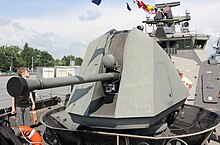


- Halifax class (Post HCM/FELEX[21] Refit / 2x MK3 operational prior to Halifax Class Modernization (HCM) refit)
- Sampari class (The last four ship of the class)[23]
- Swedish designations:
- 57 mm allmålspjäs Mk3
- 57 mm allmålspjäs Mk3B
- Swedish usage:
- US designation:
- Mk 110 57mm gun
- US usage:
See also[edit]
- Bofors 40 mm L/60 gun
- Bofors 40 mm Automatic Gun L/70
- Bofors 57 mm m/47 aircraft gun
- Bofors 57 mm Naval Automatic Gun L/60
- Bofors 57 mm Automatic Anti-Aircraft Gun L/60
- List of naval guns by caliber
References[edit]
- ^ a b c d e f g h i j k l m n o p q r s t u v "Bofors automatic 57mm Dual-Purpose guns". tfd.chalmers.se. Archived from the original on 2007-05-14. Retrieved 2021-10-22.
- ^ a b c "030306_SAK57_Mk3.pdf" (PDF). boflv.se. Bofors Luftvärnsförening (Bofors Anti-Aircraft Association). 2003. Archived (PDF) from the original on 2010-09-11. Retrieved 2021-11-19.
- ^ a b c d e f g h i j "Sweden 57 mm/70 (2.25") SAK Marks 1, 2 and 3 / United States 57 mm/70 (2.25") Mark 110 Mod 0". NavWeaps.Com. 10 April 2008. Archived from the original on 3 September 2011. Retrieved 22 September 2011.
- ^ French Navy FTI Frigate: From 57mm to 127mm, Naval Gun System Choice Still Open Archived 2016-10-31 at the Wayback Machine - Navyrecognition.com, 28 October 2016
- ^ a b "57mm Naval Gun System". baesystems.com. Archived from the original on 2015-10-29. Retrieved 2021-11-26.
- ^ AMKAT, Ammunitionskatalog för marinen, Data och bilder, 1990 års utgåva (in Swedish). Sweden: Försvarets materielverk. 1990. pp. 39, 40, 43, 44.
- ^ "Navy League 2018: BAE Systems wins LCS naval gun contract". Jane's 360. Archived from the original on 2018-04-12. Retrieved 2018-04-11.
- ^ "40 and 57 mm 3P ammunition". BAE Systems. 2006. Archived from the original on 26 September 2011. Retrieved 22 September 2011. updated page
- ^ BAE Systems Unveils the ORKA One Shot One Kill Round for 57mm Gun at Sea-Air-Space 2015 Archived 2015-09-22 at the Wayback Machine - Navyrecognition.com, 14 April 2015
- ^ A Year Into Distributed Lethality, Navy Nears Fielding Improved Weapons, Deploying Surface Action Group Archived 2016-01-16 at the Wayback Machine - News.USNI.org, 13 January 2016
- ^ Northrop Grumman to build one-shot-one-kill shell for US Navy. New Atlas. 8 October 2023.
- ^ "Northrop Grumman to Develop New Guided Ammunition for the US Navy". Northrop Grumman Newsroom. Retrieved 2024-03-23.
- ^ "L3 Mustang Technology Passes U.S. Navy's Critical Design Review for Guided Projectile Program" (PDF). www2.l3t.com. Archived from the original (PDF) on 28 August 2017. Retrieved 27 August 2017.
- ^ a b AMKAT, Gemensam Ammunitionskatalog, Data och bilder, 2001 års upplaga (in Swedish). Sweden: Försvarets materielverk. 2001. pp. 52, 53.
- ^ AMKAT, Gemensam Ammunitionskatalog, Data och bilder, 2011 års upplaga (in Swedish). Sweden: Försvarets materielverk. 2011. p. 95.
- ^ AMKAT, Gemensam Ammunitionskatalog, Data och bilder, 2014 års upplaga (in Swedish). Sweden: Försvarets materielverk. 2014. p. 95.
- ^ a b c d "57-mm Mk 110 Mod 0 Naval Gun System". BAE Systems. Archived from the original on 30 September 2009. Retrieved 22 September 2011.
- ^ "FUZE 3P Programmable All-Target Ammunition | BAE Systems | International". Archived from the original on 2018-10-29.
- ^ a b c d e "Naval vessels as built by Lurssen GmbH". Lurssen-Defence.com. Archived from the original on 12 January 2014. Retrieved 26 January 2014.
- ^ "Mindef Accepts 2 Darussalam-Class Offshore Patrol Vessels" (Press release). Government of Brunei. Archived from the original on 2 April 2012. Retrieved 22 September 2011.
- ^ Frigate Equipment Life Extension
- ^ Vavasseur, Xavier (2019-08-20). "BAE Systems 57mm Gun Systems Selected for Indonesia's New KCR-60M". Naval News. Retrieved 2021-09-17.
- ^ "BAE Systems awarded naval guns contract for U.K.'s Type 31 frigate program". 1 October 2020.
External links[edit]
- BBC article
- Bofors Defence - Naval Guns and Programmable Ammunition
- Bofors 57mm MK3 Naval Gun System
- Jane's info on Bofors 57 mm gun
- NavWeaps.Com: Bofors 57 mm/70
Video



